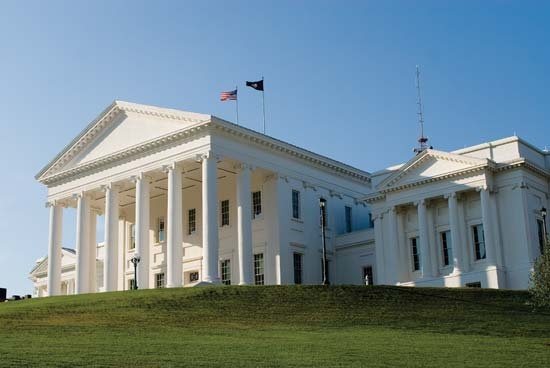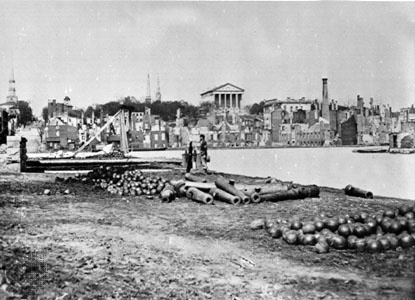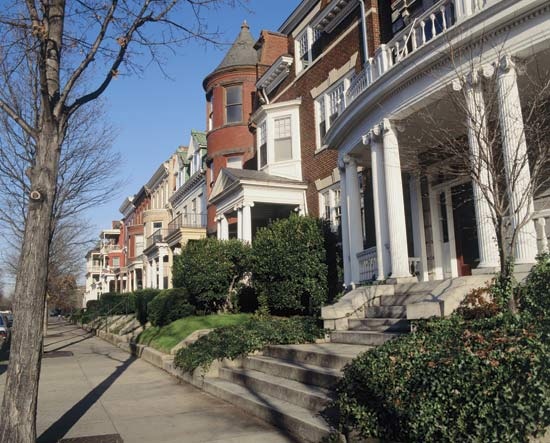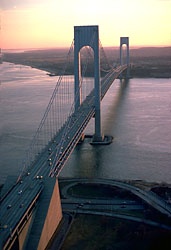Richmond
California, United States
port city, Contra Costa county, western California, U.S. It lies on the northeastern shore of San Francisco Bay and is connected to Marin county by the Richmond–San Rafael Bridge (1956), 16 miles (26 km) northeast of San Francisco. The site of ancient Ohlone Indian shell mounds, it became part of Rancho San Pablo, settled by Francisco Castro in 1823. Ferry service was established to San Francisco in 1900 when Point Richmond became the western terminus of the Santa Fe Railway. The city was home to a large winery in the early 1900s until Prohibition forced its closure. Deepwater harbour facilities encouraged development as an oil-refining centre, and World War II-era naval construction at the Kaiser shipyards, which produced more than 750 warships, greatly stimulated growth. The contribution of women to industrial labour in World War II is commemorated in the Rosie the Riveter Memorial (completed 2000), sited in Marina Bay Park on the grounds of the former shipyards. Diversified manufactures include petroleum, chemicals, biotechnology, auto parts, and aerospace components. Point Molate was a U.S. naval fuel depot centre until it was decommissioned in 1995. Recreational sites in the area include Miller Knox Regional Shoreline, Sobrante Ridge Regional Preserve, and Point Pinole Regional Park. Inc. 1905. Pop. (1990) 87,425; (2000) 99,216.
Indiana, United States
city, seat (1873) of Wayne county, east-central Indiana, U.S. It is located on the East Fork of Whitewater River, 67 miles (108 km) east of Indianapolis at the Ohio border. Settled in 1806 by migrating North Carolina Quakers (Friends, Society of), it was first called Smithville and in 1818 amalgamated with neighbouring Coxborough (or Jericho) and incorporated as Richmond, a name supposedly indicative of the richness of local soil. The town's growth was spurred by its location on the Cumberland (or National) Road, which reached Richmond in about 1835. Richmond has remained a centre of Quaker influence and organizations. The publications and general offices of the Friends United Meeting (Quakers) are located there, and group sessions are held regularly. The city is the seat of Earlham College (1847; Quaker-controlled) and Indiana University East (1971). An early manufacturing centre in a fertile area, Richmond is still important in agricultural marketing and processing. Industries include the manufacture of machinery, automobile parts, and fabricated metals. An annual rose festival held in June reflects the city's large greenhouse rose-growing industry. A statue (“Madonna of the Trail,” 1928) in Glen Miller Park in downtown Richmond commemorates the westward flow of pioneers along the Cumberland Road through the city. The Indiana Football Hall of Fame and Wayne County Historical Museum are also in the city. Inc. city, 1840. Pop. (2000) 39,124; (2005 est.) 37,560.
Kentucky, United States
city, seat (1798) of Madison county, east-central Kentucky, U.S., in the outer Bluegrass region, near the Cumberland foothills. The city, on the old Wilderness Road, 25 miles (39 km) southeast of Lexington, was settled in 1785 by Colonel John Miller, who served at Yorktown during the American Revolution. It is named for Richmond, Virginia, Miller's birthplace. Richmond was contested throughout the American Civil War. The first Confederate victory in the state took place there on August 29–30, 1862, when General Edmund Kirby-Smith (Kirby-Smith, E.)'s forces defeated the troops of the Union general William Nelson, capturing nearly all of Nelson's men. The courthouse (1849) was used as a hospital during the war.
Richmond is an agricultural trading and shipping centre for tobacco, livestock, and corn (maize); the manufacture of lighting and electronic equipment, cable, storage batteries, and paint products are important to the economy. The city is the home of Eastern Kentucky University, founded in 1906. Fort Boonesborough State Park is there, and Natural Bridge State Park is nearby, to the east. White Hall State Historic Shrine, 5 miles (8 km) to the north, is the restored home (1799) of abolitionist Cassius Marcellus Clay (Clay, Cassius Marcellus). Inc. 1809. Pop. (1990) 21,155; (2000) 27,152.
New South Wales, Australia
town, part of the Hawkesbury local government area, east-central New South Wales, Australia, on the Hawkesbury River. It is situated on a hill, was named in 1789 after the Duke of Richmond by Governor Arthur Phillip, and was chosen in 1810 for settlement by Governor Lachlan Macquarie as safe from flood damage. Proclaimed a municipality in 1872, Richmond has since become a suburb of Sydney (35 miles 【56 km】 southeast). Fertile riverine flats surrounding the town yield vegetables, corn (maize), turf, and dairy products, much of which is processed in Richmond. Hawkesbury Agricultural College (founded 1888) and a Royal Australian Air Force airfield are nearby. Pop. (2006) Hawkesbury local government area, 60,561.
North Yorkshire, England, United Kingdom
town (“parish”), Richmondshire district, administrative county of North Yorkshire, historic county of Yorkshire, northern England, situated on the left bank of the River Swale where its dale (upland valley) opens into the plain. Richmond grew up in the shelter of a Norman castle (c. 1071), only the keep of which remains, and became the main military centre and market for a large part of northwestern Yorkshire. It is the hometown of the Catterick garrison, with its camp nearby on a Roman site, and prospers as the main tourist centre for the Yorkshire Dales National Park. It also has a restored 18th-century theatre. Pop. (2001) 8,178.
Tasmania, Australia
town, southeastern Tasmania, Australia, situated on Coal River at the head of Pitt Water lagoon. In 1815 Tasmania's first flour mill was built in the area, and by 1823 a bridge (Australia's oldest existing bridge) was built across the river to provide access from Hobart (16 miles 【26 km】 southwest) and to the east coast and Tasman Peninsula. Two years later, the government founded the town, which prospered from wheat farming during the 1830s. From 1861 Richmond was the centre of a municipality (from 1993 within Clarence), but it declined after 1872 when bypassed by causeways across Pitt Water. It remains a service centre for local sheep, dairy, and mixed farms, and vineyards. Richmond is a well-preserved historic town and a popular tourist attraction. Pop. (2001) locality, 818.
Virginia, United States
 city, capital of Virginia, U.S., seat (1752) of Henrico county, situated in the east-central part of the state at the head of navigation of the James River. Politically independent of the county, it is the centre of a metropolitan area including the rest of Henrico county and Chesterfield and Hanover counties. The English first explored the site in 1607, when a party led by Christopher Newport and John Smith (Smith, John) sailed upriver shortly after the founding of Jamestown (Jamestown Colony). A trading post was established (1637) by Thomas Stegg at the fall of the James, and in 1645 Fort Charles was built there. In 1733 William Byrd of Westover named the settlement for Richmond upon Thames, England, and the town was laid out four years later by surveyor Major William Mayo on a site that became known as Church Hill.
city, capital of Virginia, U.S., seat (1752) of Henrico county, situated in the east-central part of the state at the head of navigation of the James River. Politically independent of the county, it is the centre of a metropolitan area including the rest of Henrico county and Chesterfield and Hanover counties. The English first explored the site in 1607, when a party led by Christopher Newport and John Smith (Smith, John) sailed upriver shortly after the founding of Jamestown (Jamestown Colony). A trading post was established (1637) by Thomas Stegg at the fall of the James, and in 1645 Fort Charles was built there. In 1733 William Byrd of Westover named the settlement for Richmond upon Thames, England, and the town was laid out four years later by surveyor Major William Mayo on a site that became known as Church Hill. The Virginia convention of 1774, forming a standing body of anti-British sentiment, met there. During the American Revolution Richmond replaced Williamsburg as the state capital (1779), and the town was pillaged by the British under Benedict Arnold (Arnold, Benedict) in January 1781. Construction of the present capitol building, designed by Thomas Jefferson (Jefferson, Thomas), began in 1785. In 1840 the city was linked to Lynchburg by the James River and Kanawha Canal, and by 1860 it was served by several railroads. Following the secession of Virginia (April 1861) at the outbreak of the American Civil War, the capital of the Confederacy was moved (July 1861) from Montgomery, Alabama, to Richmond. It thus became a major Union military target. In 1862 General George B. McClellan (McClellan, George B)'s Army of the Potomac approached the city but was driven away in the Seven Days' Battles (June 25–July 1). It was not again seriously threatened until the siege of Richmond and Petersburg (Petersburg Campaign) (June 1864). Finally, on April 3, 1865, General Ulysses S. Grant (Grant, Ulysses S.) broke the Confederate defense and took the city; much of the business district was burned during its evacuation. Richmond recovered rapidly during the Reconstruction era, mainly because of its prosperous tobacco industry.
The Virginia convention of 1774, forming a standing body of anti-British sentiment, met there. During the American Revolution Richmond replaced Williamsburg as the state capital (1779), and the town was pillaged by the British under Benedict Arnold (Arnold, Benedict) in January 1781. Construction of the present capitol building, designed by Thomas Jefferson (Jefferson, Thomas), began in 1785. In 1840 the city was linked to Lynchburg by the James River and Kanawha Canal, and by 1860 it was served by several railroads. Following the secession of Virginia (April 1861) at the outbreak of the American Civil War, the capital of the Confederacy was moved (July 1861) from Montgomery, Alabama, to Richmond. It thus became a major Union military target. In 1862 General George B. McClellan (McClellan, George B)'s Army of the Potomac approached the city but was driven away in the Seven Days' Battles (June 25–July 1). It was not again seriously threatened until the siege of Richmond and Petersburg (Petersburg Campaign) (June 1864). Finally, on April 3, 1865, General Ulysses S. Grant (Grant, Ulysses S.) broke the Confederate defense and took the city; much of the business district was burned during its evacuation. Richmond recovered rapidly during the Reconstruction era, mainly because of its prosperous tobacco industry. Tobacco remains important economically; printing and publishing and the manufacture of chemicals, textiles, pharmaceuticals, metals, and wood and paper products are also significant. The University of Richmond (Richmond, University of) (Baptist) was founded as Dunlora Academy in 1830; other educational institutions include Union Theological Seminary (1812), Virginia Union University (1865), Virginia Commonwealth University (formed in 1968 by the merger of Richmond Professional Institute 【1917】 and Medical College of Virginia 【1838】), and J. Sargeant Reynolds Community College (1972). Among its historic buildings are St. John's Church (1741), where patriot Patrick Henry (Henry, Patrick) delivered his “Liberty or Death” address in 1775; the home (1790) of Chief Justice John Marshall (Marshall, John); the White House of the Confederacy (1818; now a museum); Robert E. Lee (Lee, Robert E.) House (1844); Edgar Allan Poe (Poe, Edgar Allan) Museum (Poe edited the Southern Literary Messenger in Richmond from 1835 to 1837); Valentine Museum (1812; depicting Richmond's history); and Battle Abbey of the Virginia Historical Society (1913).
Tobacco remains important economically; printing and publishing and the manufacture of chemicals, textiles, pharmaceuticals, metals, and wood and paper products are also significant. The University of Richmond (Richmond, University of) (Baptist) was founded as Dunlora Academy in 1830; other educational institutions include Union Theological Seminary (1812), Virginia Union University (1865), Virginia Commonwealth University (formed in 1968 by the merger of Richmond Professional Institute 【1917】 and Medical College of Virginia 【1838】), and J. Sargeant Reynolds Community College (1972). Among its historic buildings are St. John's Church (1741), where patriot Patrick Henry (Henry, Patrick) delivered his “Liberty or Death” address in 1775; the home (1790) of Chief Justice John Marshall (Marshall, John); the White House of the Confederacy (1818; now a museum); Robert E. Lee (Lee, Robert E.) House (1844); Edgar Allan Poe (Poe, Edgar Allan) Museum (Poe edited the Southern Literary Messenger in Richmond from 1835 to 1837); Valentine Museum (1812; depicting Richmond's history); and Battle Abbey of the Virginia Historical Society (1913).The nearby Richmond National Battlefield Park (established 1936) commemorates seven Civil War battles that were fought in and around the city in 1862–65. The park, with a total area of 2.7 square miles (7 square km), comprises 10 units spread out within the city and across three surrounding counties. Many notable Southerners, including U.S. presidents John Tyler (Tyler, John) and James Monroe (Monroe, James) and Confederate president Jefferson Davis (Davis, Jefferson), as well as 18,000 Confederate soldiers, are buried in the city's Hollywood Cemetery. The Virginia Museum of Fine Arts (1934) was America's first state-supported art museum. Inc. city, 1782. Pop. (2000) city, 197,790; Richmond MSA, 1,096,957; (2007 est.) city, 200,123; Richmond MSA, 1,212,977.
county, New York, United States
 county (area 58 sq mi 【48 sq km】), southeastern New York, U.S., coextensive with Staten Island borough, which comprises Staten Island (q.v.) and part or all of several smaller islands in New York Harbor. The borough is linked to Brooklyn by the Verrazano-Narrows Bridge (see photograph-->
county (area 58 sq mi 【48 sq km】), southeastern New York, U.S., coextensive with Staten Island borough, which comprises Staten Island (q.v.) and part or all of several smaller islands in New York Harbor. The borough is linked to Brooklyn by the Verrazano-Narrows Bridge (see photograph--> ). The first permanent settlement was made under Dutch authority in 1661 at Oude Dorp (Old Town). Three years later the British took control. Richmond County (named for Charles Lennox, 1st duke of Richmond and natural son of Charles II) was organized in 1683.
). The first permanent settlement was made under Dutch authority in 1661 at Oude Dorp (Old Town). Three years later the British took control. Richmond County (named for Charles Lennox, 1st duke of Richmond and natural son of Charles II) was organized in 1683.- Elhuyar, Fausto
- Eliade, Mircea
- Elia Kazan
- Elias Boudinot
- Elias Canetti
- Elias Fries
- Elias Hicks
- Elias Howe
- Elias James Corey
- Elias Lönnrot
- Elias, Norbert
- Elias Of Cortona
- Eliel Saarinen
- Elie Nadelman
- Elie Wiesel
- Eliezer Sukenik
- Eli Filip Heckscher
- Elihu Root
- Elihu Thomson
- Elihu Vedder
- Elihu Yale
- Elijah
- Elijah ben Solomon
- Elijah Bokher Levita
- Elijah Delmedigo